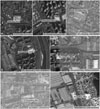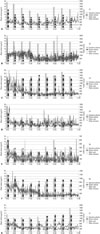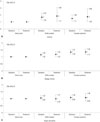DISCUSSION
The present study showed that traffic-related and other pollutants around primary school areas are associated with increased risks of allergic diseases among elementary school students. The average PM
10 concentration around schools in this study peaked at 53.0 µg/m
3 in traffic-related zone schools (school 2 has an express bus terminal nearby) and exceeded the standard value that the World Health Organization (WHO) recommends (AQG value, 24 h 50 µg/m
3/WHO AQG value, 24 h 50 µg/m
3). In comparison with Kim, et al.,
1 it was highest with 67.9 µg/m
3 at S2 where traffic pollutants exist (bus lanes). The measured results of PM
10 using beta-ray could be overestimated or underestimated due to environmental conditions such as road moisture.
29
The averages of the seven schools for SO
2 (EPA standard 24 h 0.14 ppm/WHO AQG value, 24 h 20 µg/m
3), NO
2 (EPA standard, 1 h 100 ppb, 188 µg/m
3/WHO AQG value, 1 h 200 µg/m
3), CO (EPA standard, 8 h 9 ppm), and O
3 (EPA standard, 8 h 0.075 ppm) were 0.005 ppm, 0.024 ppm, 0.40 ppm, and 0.025 ppm respectively, each of which is below the standard value set by the EPA/WHO, and each of which is similar to the seven schools studied by Kim, et al.
1
Among traffic-related zone schools, BC was highest, at 7.34 µg/m
3, in the school with highest truck traffic (S3). In the results, the schools in industrial complexes showed higher BC levels than at S2, S3, and S4, as demonstrated by the 6.91 µg/m
3 and 10.98 µg/m
3 average measurements for the two schools in industrial complexes (S5, S6, respectively).
1 In addition, the S2 and S3 category schools are located in traffic-related pollution areas, including downtown Seoul. The S4 school is located near the Daejeon IC where the Gyeongbu Express Highway is in school back and where bus garages and a residential area are located. One of the complex pollution areas located in the S5 school in the Nan-dong industrial complex is 100 meter away. S6 school is located in the city of Siheung City, Gyeonggi-do, is the only industry within 300 meters.
Also, the level was high during 8–9 a.m. rush hours, i.e., when students go to school, and the results of Cheng, et al.
18 also showed BC concentrations peaked during 7:00–9:00 a.m. and 4:00–6:00 p.m. However, traffic volume also differs according to the day of the week because of general air pollution. So, we measured the effect of general air pollution on all schools by taking into account the traffic count on Monday or Friday. This was necessary because air conditions and vehicle emissions were not clearly distinguished from one another, and our study failed to show the influence of common air pollutants.
In Cheng, et al.,
18 the BC level was closely related to traffic volume, especially in the morning rush hours. Most elementary schools are located on main roads for traffic convenience, and morning rush hours are identical with the hours when school students come to and leave school (8:00 a.m.–9:00 a.m.). Hence, BC exposure occurs directly and indirectly in school zones, playgrounds, and classrooms. In Korean school zones, people are encouraged to drive less than 30 km/hour on roads located within 500 m of schools.
1 In addition, the BC concentration was higher in the schools where the distance between major roads and school is short and the concentration was lower at the locations farther from major roads. It was also found that BC generated on adjacent roads enters classrooms, where children are exposed. BC aerosol is a substance emitted from the incomplete combustion of fossil fuel and traffic in the urban environment, and transportation is the leading contributor to BC emissions in downtown areas.
18,
30,
31 Reche, et al.
32 reported that the BC concentration levels in downtowns and background concentration levels in six European cities were 0.7–1.9 µg/m
3. The average concentration of 3.70–7.34 µg/m
3 in school zones adjacent to major roads and the average playground concentration of 2.46–5.34 µg/m
3 among the seven schools in the present study were estimated to be comparable to the concentration level in the downtown area in Reche, et al.
32 Importantly, the BC concentration measured indoors is higher than the background concentration level suggested by Reche, et al.,
32 with a concentration of 1.01–5.24 µg/m
3 in classrooms on lower floors (2nd floor) and of 1.03–4.76 µg/m
3 in classrooms on higher floors (4th floor). Such school environments are expected to increase the potential for allergic disease. Diesel particles have been shown to enhance inflammatory reactions and sensitisation.
33 However, this study is limited by short-term measurements, i.e., measurements over one day per site (one on the road in the school zone near the front gate and one on the playground), providing data for only two days per school.
In this study, the results on the association between allergic disease of elementary school students and major air pollutants such as BC in seven schools showed that ORs significantly increased (
p<0.05) with SO
2 for the symptoms experienced during the past 12 months in traffic-related zones, and likewise increased with NO
2 in the treatment history during the past 12 months in complex source zones. BC levels showed positive associations are not significant. The similar study by Kim, et al.
1 had no air pollutants that showed a statistically significant association with asthma in asthma symptoms and treatment experienced during the past 12 months, but they showed positive associations with, BC, PM
10, and SO
2. Gruzieva, et al.
29 conducted a study on the association between exposure to traffic-related air pollution and asthma, and reported an association of 2.0 (95% CIs 1.1–3.5) with PM
10 exposure among 8–12 year old children, which was similar with NOx as well. In the present study, the association with PM
10 was not present, but the association with NO
2. The Taiwanese study of Lee, et al.
34 reported an association between asthma in children and NO
2 (1.42, 95% CIs 1.21–1.66), but some studies including Peters, et al.
35 reported no association between exposure to PM
10 and NO
2 and children's asthma symptoms. In
Table 4, the children have more asthma symptoms related to SO
2, but they showed an increase in treatment related to NO
2. One conclusion drawn by Liu, et al.
22 is that the association of SO
2 and NO
2 concentrations to the prevalence of respiratory symptoms is statistically significant among girls but not among boys. In our study, this was not confirmed, so it warrants further study.
In the case of allergic rhinitis, the ORs increased significantly in all subjects in their treatment histories of the past 12 months with exposure to BC, SO
2, and NO
2 (
p<0.01). Kim, et al.
1 showed that the OR for the history of allergic rhinitis treatment during the past 12 months increased significantly with exposure to BC and SO
2, results which are similar to the findings of the present study. In Annesi-Maesano, et al.,
36 although not statistically significant, positive associations were reported between allergic rhinitis among primary school children and PM
2.5 1.09 (95% CIs 0.93–1.27), NO
2 1.08 (95% CIs 0.92–1.27). For atopic dermatitis, the odds that symptoms were experienced during the past 12 months increased by 1.14 (95% CIs 1.00–1.30) per 0.01 ppm increase in O
3 in all subjects, at a statistically significant level (
p<0.05). In Kim, et al.
1 similar results were obtained: the OR for atopic dermatitis symptoms increased with O
3 at a statistically significant level.
Table 5 shows that children experience a decrease in the need for therapy related to allergic rhinitis in traffic polluted areas compared to complex pollution areas with respect to NO
2 and O
3. Misinterpretation of data is often an issue in studies in which allergic rhinitis and asthma are assessed through parental questionnaires, particularly in young children who have less distinctive symptoms.
It is important to note that children only spend a fraction of their school hours in the classroom, and move between classrooms and visit playgrounds and other locations within their schools. In addition, none of these studies mention any associations between exposure and daily activity pattern at school,
37 nor do they study the toxicological associations with indoor and outdoor levels.
17 In studies on pollutants, results can vary significantly depending on research scale, design, materials measured, measurement instrument, long-term and short-term measurement period, monitoring site and method.
19,
22
This study is an annual study by Kim, et al.
1 It is a significant case study focusing on major metropolitan cities. The strength of this study is thought to be the presentation of the results that simultaneously assessed the air quality on major roads near schools and inside classrooms and compared them, which has never been attempted in previous studies. In addition, in order to evaluate the connection of air quality to allergic disease, the seven schools investigated in Kim, et al.
1 and the seven schools investigated in this study were integrated and evaluated. A total of 4545 students was assessed for allergic diseases. Three school zones with critical exposure were selected withn each school and they were evaluated according to the levels of BC, PM
10, SO
2, NO
2, and O
3. The result is similar to that found by Kim, et al.,
1 which had an identical research design. For the reasons determined in the previous study, the results were used to represent the spatial distribution of air quality levels around the primary school and in adjacent areas during school hours in the Korean case study.
However, in these studies, measuring changes in air quality at schools is extremely important.
37 In terms of assessing the environmental pollution of the seven elementary schools included in the present study, it would be ideal to use automatic monitoring data from installations in respective school areas, but such data is provided from sites a few dozen kilometers away, so their data cannot reflect the state of air pollution around the seven schools.
1 Therefore, this study selected two sites that can fairly represent school air quality, and obtained representative data using automatic measuring vehicles. However, this study is limited by the short measurement period per site. As well, our study findings are limited by the short measuring period (2 days) per school. The study should at least have performed longer sampling periods and used a fixed between-site effect to correct the temporal variability due to the fact that sampling was performed simultaneously at all locations.
1 The levels of the pollutants in the ambient atmosphere could be influenced by the climate conditions (seasonal variations) such as wind speeds and directions.
2,
13 However, the pollution levels in the studied cities have been sO
3 during the last years, suggesting that emissions of pollutant evaluated in this study may not have changed much.
This study shows the results of 7 schools tested by an autonomous measuring vehicle. In this sense, there is a fundamental limit insofar as air pollution was evaluated every other day during the 5 month period. We revised the annual regional average concentration for exposure of air pollution during long periods in relevant areas. However, we decided that each material concentration did not affect the outcomes because variations in each material concentration were insignificant. The study also has a fundamental limitation because data were not obtained in the seven primary schools during the same period simultaneously, although weather conditions such as temperature and relative humidity were very similar in each school.
Furthermore, this study has the limitation of all cross-sectional studies; therefore, a causal inference cannot be made, and a comprehensive assessment of the residence and residential environment where most of the day is spent was not made.
19 Also, this study has a limitation because factors such as genetic influences, climate, diet, body mass index and social cultural factors that are known to influence allergic diseases were not considered.
1,
17,
36,
38
Finally, the survey responses in this study showed that children whose parents smoke, i.e., children exposed to indirect smoking, accounted for 20.2% of all subjects, which is believed to affect the odds of allergic disease. Also, 24.9% were found to be exposed to indirect smoking at home.
1 Although some studies have reported no association between indirect smoking and respiratory symptoms such as asthma, other studies have shown an association.
22,
39,
40,
41,
42
In recent studies, concerns have been raised about the association between students' allergic diseases such as asthma and air pollution around elementary schools. BC, PM, NO2, SO2, and O3 have been mostly mentioned as hazardous materials, and vehicles are known as major contributing sources of these substances. Therefore, this study attempted to assess the association between the elementary school students' history of symptoms and treatments of asthma, allergic rhinitis, and atopic dermatitis and the distribution of the previously mentioned and exposed hazardous substances in seven schools.
The study results showed that risk increased significantly with SO
2 exposure in traffic-related zones in the history of asthma symptoms, and with NO
2 exposure in complex source zones in the treatment history of asthma. As for the history of allergic rhinitis treatment, risk increased significantly due to BC and NO
2 exposure in all subjects, and as for the history of atopic dermatitis symptoms, the risk increased significantly with O
3 exposure in all subjects. According to the results of the evaluation of the integrated data between the seven schools in Kim, et al.
1 and the seven schools in the present study, in the history of symptoms during the past 12 months, the risk of asthma, allergic rhinitis, and atopic dermatitis was higher among children in schools in traffic-related zones and complex source zones compared to the risks experienced by children in the school in the control group (S1). However, in our study, changes in environmental exposures may have resulted in bias.
22 Our air pollutant measurements were only available for a limited time period (2 days), so it may not be representative of the schools. Previous studies made the same point.
2,
29 In addition, although air pollutant levels were measured during the study period, we did not include air pollutant data in the analysis as we did not have school-based measurements.
Therefore, care and prevention measures must be given to spaces used in coming to and leaving schools, as well as in playgrounds and classrooms, to ensure not only the safety of children from traffic accidents but also to ensure their protection from nearby traffic pollutants and various hazardous materials.
This study used logistic regression between six air pollutants (average of seven schools' air pollutant concentration) and the allergy disease status of all students of all schools. Thus, there is an ecological fallacy. In other words, this study has some limits as cross-section research in that the measurement of allergy levels involved a subjective point of view and air pollutant concentrations were measured at particular schools. However, we confirm that
Table 4,
5, and
6 satisfy the Hosmer-Lemeshow goodness of fit test (
p>0.05).
Finally, this study has another limit: it leaves uncertain the relationship between air pollution concentration and allergy severity. From now on, we expect to remedy the limits since this study will use lag time as analysis of reason variable about the past.













 PDF
PDF ePub
ePub Citation
Citation Print
Print



 XML Download
XML Download